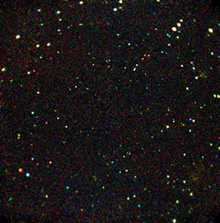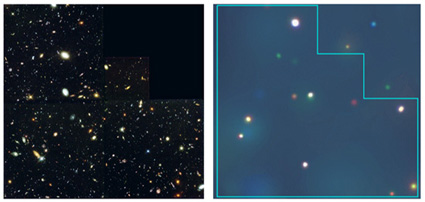March 13, 2001
NASA PR: 01-37
For the first time, astronomers believe they have proof black holes of all sizes once ruled the universe. NASA's Chandra X-ray Observatory provided the deepest X-ray images ever recorded, and those pictures deliver a novel look at the past 12 billion years of black holes.
Two independent teams of astronomers today presented images that contain the faintest X-ray sources ever detected, which include an abundance of active super massive black holes.
"The Chandra data show us that giant black holes were much more active in the past than at present," said Riccardo Giacconi, of Johns Hopkins University and Associated Universities, Inc., Washington, DC. The exposure is known as "Chandra Deep Field South" since it is located in the Southern Hemisphere constellation of Fornax. "In this million-second image, we also detect relatively faint X-ray emission from galaxies, groups, and clusters of galaxies".
The images, known as Chandra Deep Fields, were obtained during many long exposures over the course of more than a year. Data from the Chandra Deep Field South will be placed in a public archive for scientists beginning today.
"For the first time, we are able to use X-rays to look back to a time when normal galaxies were several billion years younger," said Ann Hornschemeier, Pennsylvania State University, University Park. The group’s 500,000-second exposure included the Hubble Deep Field North, allowing scientists the opportunity to combine the power of Chandra and the Hubble Space Telescope, two of NASA's Great Observatories. The Penn State team recently acquired an additional 500,000 seconds of data, creating another one-million-second Chandra Deep Field, located in the constellation of Ursa Major.
The images are called Chandra Deep Fields because they are comparable to the famous Hubble Deep Field in being able to see further and fainter objects than any image of the universe taken at X-ray wavelengths. Both Chandra Deep Fields are comparable in observation time to the Hubble Deep Fields, but cover a much larger area of the sky.
"In essence, it is like seeing galaxies similar to our own Milky Way at much earlier times in their lives," Hornschemeier added. "These data will help scientists better understand star formation and how stellar-sized black holes evolve." Combining infrared and X-ray observations, the Penn State team also found veils of dust and gas are common around young black holes.
Another discovery to emerge from the Chandra Deep Field South is the detection of an extremely distant X-ray quasar, shrouded in gas and dust. "The discovery of this object, some 12 billion light years away, is key to understanding how dense clouds of gas form galaxies, with massive black holes at their centers," said Colin Norman of Johns Hopkins University.
The Chandra Deep Field South results were complemented by the extensive use of deep optical observations supplied by the Very Large Telescope of the European Southern Observatory in Garching, Germany. The Penn State team obtained optical spectroscopy and imaging using the Hobby-Eberly Telescope in Ft. Davis, TX, and the Keck Observatory atop Mauna Kea, HI.
Chandra's Advanced CCD Imaging Spectrometer was developed for NASA by Penn State and Massachusetts Institute of Technology under the leadership of Penn State Professor Gordon Garmire. NASA's Marshall Space Flight Center, Huntsville, AL, manages the Chandra program for the Office of Space Science, Washington, DC. TRW, Inc., Redondo Beach, California, is the prime contractor for the spacecraft. The Smithsonian's Chandra X-ray Center controls science and flight operations from Cambridge, MA. More information is available on the Internet at:
MEDIA CONTACTS
Dolores Beasley
Headquarters, Washington, DC
Phone: 202/358-1753
Steve Roy
Marshall Space Flight Center, Huntsville, AL
Phone: 256-544-6535
Megan Watzke
Chandra X-ray Observatory Center, CfA, Cambridge, MA
Phone: 617-496-7998




